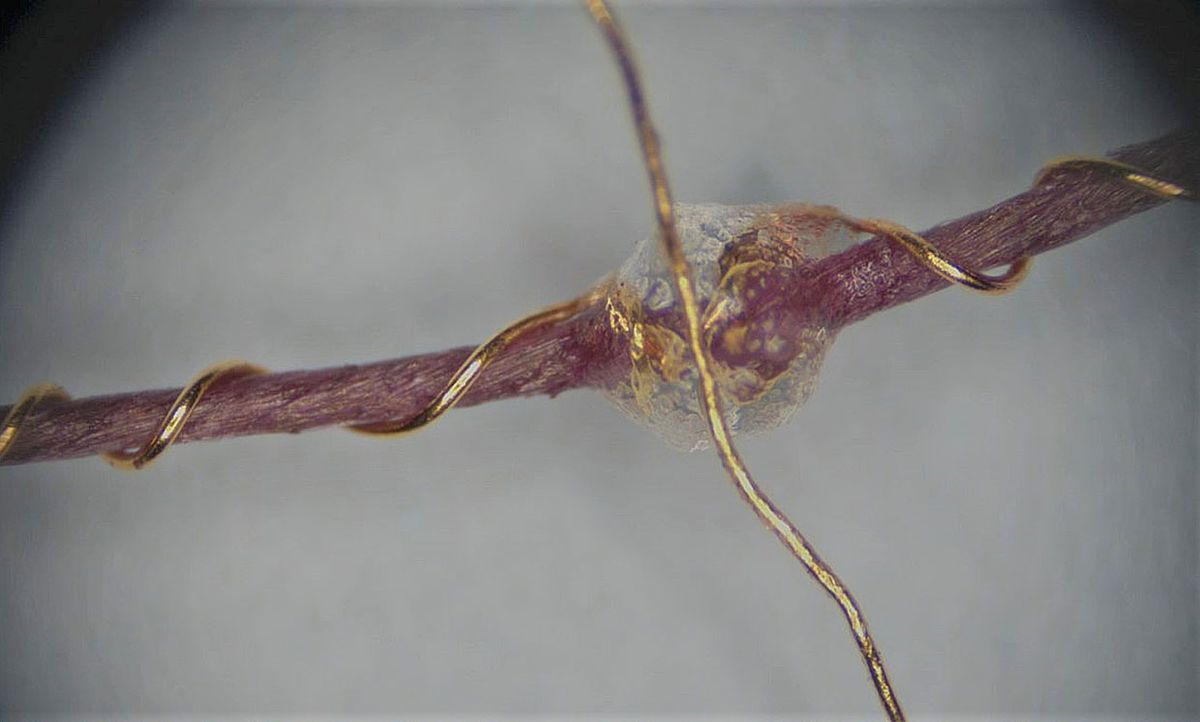Flexible electronics that could be worn on, stuck to, or even implanted in your body need to be able to twist, bend, or fold. And when it comes to that range of motion, nothing beats a single thread.
“Threads are the ultimate in flexibility,” says Sameer Sonkusale, an electrical engineer at Tufts University.
In 2016, Sonkusale and his team used cotton threads to create microfluidic sensors that can measure things like temperature and pH. Last month, in a proof-of-concept experiment, Sonkusale’s group reported making thread-based transistors, and demonstrated their utility as logic gates and multiplexers.
On standard linen sutures, Rachel Owyeung, Sonkusale’s PhD student and first author of the study, wound two thin gold wires acting as the source and drain electrodes of the transistor. Then, she pipetted a solution of semiconducting material—either single-walled carbon nanotubes or a semiconducting polymer, poly(3-hexylthiophene-2,5-diyl)—onto the thread by hand. The solution’s organic solvent evaporated quickly, leaving behind an even layer of semiconductors on the thread when dry.

The next layer is the gate, which controls the conductivity between source and drain electrodes and thus switches the device on or off. For the gate dielectric, the researchers went with a clear, gooey material called an ionogel. A blob of ionogel was placed on the thread between source and drain electrodes, and finally, a third gold wire—the gate electrode—was stuck on top.
On most transistors, the gate dielectric is only a few nanometers thick, Sonkusale says. With ionogels, the ions within self-assemble into an electric double layer at the semiconductor’s surface when voltage is applied to the gate electrode. This double layer acts as the gate dielectric.
To make the ionogel, Owyeung mixed a commercially-available ionic liquid—a salt that is liquid at room temperature—with silica nanoparticles for five minutes. The silica nanoparticles bonded weakly to themselves, forming an extended network throughout the ionic liquid and propping it up into a gel.
The researchers assembled the p-type, carbon nanotube-based transistors into logic gates performing NAND, NOR, and NOT operations by twisting the appropriate gold source and drain electrodes together. They also connected three transistors to three thread sensors, that measure sodium and ammonium ion levels, by simply winding the gold source electrode around the thread sensors as well. Then, they used the transistors to select which sensor an output monitor reads from.
“We wanted to demonstrate that the transistors have more than one utility,” Sonkusale says.
The researchers are working on several fronts to improve the suite of thread electronics, including finding cheaper alternatives to gold electrodes and developing ways to automate and scale up the assembly process. For example, the semiconducting material could be deposited on the threads with a printhead rather than by hand, Owyeung says.
“One of the advantages of threads is that they have been processed for so long, they have a very diverse portfolio of fabrication methods,” she says, which could make it easier to incorporate them into existing fabs to make thread-based electronics.



